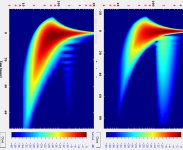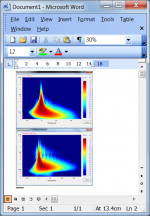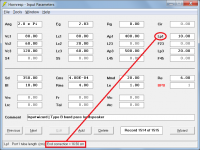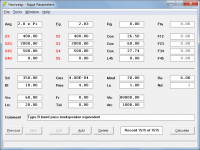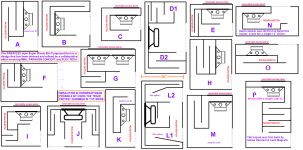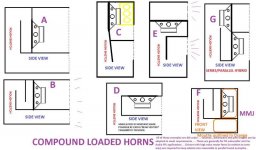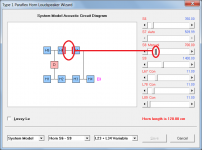Sure, I turn my back on McBean and he changed the world again... I was so busy Using HR that I didn't take time to read the HR thread!
Two Questions:
1) Can Freddy model his Karlsons with that thing?
2) Does this thing model horns anymore?
🙂
Thank you, David!
Two Questions:
1) Can Freddy model his Karlsons with that thing?
2) Does this thing model horns anymore?
🙂
Thank you, David!
Yes to both questions! However, it a PITA to calculate that Karlson exit. Also, a Paraflex is a form of a stepped TH.
Is there a way to make the graphs static so that comparison can be easier to see visually?
It's not going to happen 🙂.
If I have a need to compare such things, I simply take form prints (press Alt + Prt Scr keys) and paste them into an open blank document in Microsoft Word. It's very quick and easy to do. (In the attached example the Zoom setting has been reduced to 30% to fit everything into the image shown).
It is not actually necessary to copy both results - just put the first into Word and compare it to the second in Hornresp.
Attachments
A compound resonant thing
BP1Fan ,
Even though we do (or did previously) use Hornresp's "TH" mode to simulate Paraflex cabinets the addition of the High-Tuned resonator makes them something significantly different than a TH, a compound loaded creature more closely related to a Compound Horn (or Compound QW) design with the ends of it's resonators merged to share a single mouth 🙂.
BP1Fan ,
Even though we do (or did previously) use Hornresp's "TH" mode to simulate Paraflex cabinets the addition of the High-Tuned resonator makes them something significantly different than a TH, a compound loaded creature more closely related to a Compound Horn (or Compound QW) design with the ends of it's resonators merged to share a single mouth 🙂.
Thank You so much for all that you do.
David, you are the Patron Saint of Benevolence in Coding .... Your relentless altruism is inspirational
David, you are the Patron Saint of Benevolence in Coding .... Your relentless altruism is inspirational

Yes to both questions! However, it a PITA to calculate that Karlson exit. Also, a Paraflex is a form of a stepped TH.
Its a compound stairway to a further complicated level of incredibly interesting things that are not at any point directly related to anything except pipe physics and complex results of multiple pipes and if joined so they must exist in a symbiotic way to create or destroy sound as almost nothing but maybe a sliding trombone (pipe) with a self guided frequency pressure phase that is the imaginery slide that can insist upon what sound is actually coming out of it.
David didnt waste all that time and effort on a TH everyone is familiar with. I suggest everyone who is trully interested in the science or strangely unique science thats using all there is to stretch out into n obviously real result to be heard nd then studied! It os not perfect! But it is very very real. To assume anything and not take a look for yourself is unfortunate. Because David wasted his time then and the opportunity was given to us all, he cannot do anything more, nobody could or can. He and anyone like him have removed all of our excuses for us. If your were not making sawdust or made t and are actively looking at that and going back into the software o find MoAR than were a waste of that effort.. and shame on us for ever asking
Do it! Jump into the ring of fire, it doesnt burn, Johnny cash was daring you to see?
Last edited:
Is there a way to get the impulse response(wav) of the Type B Band Pass?
Yes, but not directly from the Band Pass Enclosure Loudspeaker Wizard.
Specify an equivalent design in the main input parameters window using stepped segments, and calculate the results with resonances not masked.
To illustrate:
Attachment 1 shows the default BPB design produced by the Input Wizard. Moving the mouse pointer over the Lp1 and Lp3 input boxes displays the port tube end correction values, which have been added to L12 and L34 in the equivalent design shown in Attachment 2. The results for the two designs are identical.
Attachments
BP1Fan ,
Even though we do (or did previously) use Hornresp's "TH" mode to simulate Paraflex cabinets the addition of the High-Tuned resonator makes them something significantly different than a TH, a compound loaded creature more closely related to a Compound Horn (or Compound QW) design with the ends of it's resonators merged to share a single mouth 🙂.
It can't be a Compound Horn and share a single mouth.
Your Paraflex single mouth (pic 1) = BP6S = stepped TH.
Compound Horn = BP6P = your Super Planar (pic 2).
Attachments
re: "Ring of Fire" - - any help to jump using the new models would be appreciated.
Hi freddi,
To get started:
1. Use the Input Wizard to create the initial paraflex record, and then edit values to suit.
2. Use the System Model in the Loudspeaker Wizard to see what parameters apply where.
Kind regards,
David
Attachments
BP1fan,
Notice I said "closely related to a Compound Horn" ... .The ends of both resonators merging to share a single mouth is what separates it from a standard Compound QW/Horn design...... The additional resonator is what makes it something other than a Tapped Horn...
Some of the Paraflex subwoofer designs are stepped and some aren't ....The Paraflex tops have a more traditional horn flare as their High-Tuned resonator section (but still merges with the other resonator path or paths near their ends to share a single mouth) ....
Notice I said "closely related to a Compound Horn" ... .The ends of both resonators merging to share a single mouth is what separates it from a standard Compound QW/Horn design...... The additional resonator is what makes it something other than a Tapped Horn...
Some of the Paraflex subwoofer designs are stepped and some aren't ....The Paraflex tops have a more traditional horn flare as their High-Tuned resonator section (but still merges with the other resonator path or paths near their ends to share a single mouth) ....
Last edited:
I think what he is asking is something I myself asked for earlier (and was turned down 😉 ) which was that the axes for both graphs could be forced to be the same. I'm not into coding any more, but I've seen many libraries which allow defining the axes. Even LabView has this capability, wherein you double-click the value shown at the end of the axis you want to modify and type in the desired value.It's not going to happen 🙂.
If I have a need to compare such things, I simply take form prints (press Alt + Prt Scr keys) and paste them into an open blank document in Microsoft Word. It's very quick and easy to do. (In the attached example the Zoom setting has been reduced to 30% to fit everything into the image shown).
It is not actually necessary to copy both results - just put the first into Word and compare it to the second in Hornresp.
Eg. in the second graph, double-click -20 and type 0 and press enter. The graph will be redrawn with the axis starting from 0. Then double-click 80 and type 60 and press enter. Now the y axis will be the same for both graphs.
I agree that it is a lot of work to code this by hand, but please do keep your eyes open for a graphing library/ control that has this functionality built in. If such a vbcontrol exists, then it is a fairly simple matter of using that instead of what you're using now.
It can't be a Compound Horn and share a single mouth.
Your Paraflex single mouth (pic 1) = BP6S = stepped TH.
Compound Horn = BP6P = your Super Planar (pic 2).
this is helpful thank you its hard to put all that in one place
BP1fan,
Notice I said "closely related to a Compound Horn" ... .The ends of both resonators merging to share a single mouth is what separates it from a standard Compound QW/Horn design...... The additional resonator is what makes it something other than a Tapped Horn...
Some of the Paraflex subwoofer designs are stepped and some aren't ....The Paraflex tops have a more traditional horn flare as their High-Tuned resonator section (but still merges with the other resonator path or paths near their ends to share a single mouth) ....
That's no different than saying a BP6S is closely related to a BP6P.
Agreed. I see your stepped versions more often...ease of build because there are no angles to deal with.
This discussion got me thinking about turbocharging.
BP6S = compound turbos = diesel pickup trucks.
BP6P = twin turbos = about every car manufacturer makes a twin turbo V6.
Based on that turbo analogy, should the CH function in HR be changed from 2 mouths to a single mouth???
- Home
- Loudspeakers
- Subwoofers
- Hornresp
